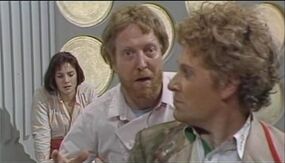Graeme Harper: Difference between revisions
No edit summary Tag: 2017 source edit |
m (Spacing issues) |
||
| Line 75: | Line 75: | ||
== Footnotes == | == Footnotes == | ||
{{reflist}} | {{reflist}} | ||
{{NameSort}} | {{NameSort}} | ||
Revision as of 14:27, 9 March 2023
Graeme Harper (born 11 March 1945[1] in London) has directed several Doctor Who television stories, being the first (and only) director of stories in both the classic 1963-1989 series of Doctor Who and the 2005 revived series.
Before becoming a director, he was assistant floor manager for Colony in Space, Planet of the Daleks (with John Cook and Sue Hedden) and Planet of the Spiders. He was also production assistant for The Seeds of Doom and Warriors' Gate. His directorial credits include episodes of the spin-off series The Sarah Jane Adventures. The first Doctor Who story that he directed was The Caves of Androzani, although he also performed uncredited directorial work on Warriors' Gate during the short period where credited director Paul Joyce was fired from production.[2]
His work on The Caves of Androzani was notable for his highly innovative directorial style at the time. Unlike his predecessors, who would observe filming from a booth and relay their instructions via the production assistant on the floor, Harper would work from the actual set, giving instructions to the actors in person. Additionally, Harper utilised more diverse and cinematic shots, offering freer and more dynamic camera control in filming. His energetic, personal style of directing was widely praised by the show's staff and audience, with Peter Davison himself stating that he would've stayed on the show longer had Harper's methods been more prevalent throughout his tenure (DCOM: The Caves of Androzani).

Harper made an uncredited on-screen appearance in Colony in Space, where a photograph of him in costume was used to portray Martin Jurgens, the Adjudicator whose credentials had been stolen by the Master. The same photograph was later reused in The Brain of Morbius to portray a past incarnation of the Doctor.[3][4]
John Nathan-Turner originally wanted Harper to direct Yellow Fever and How to Cure It, an episode penned by Robert Holmes to be part of season 23. However, the episode was abandoned when the show was put on hiatus. (INFO: The Mysterious Planet)
In 1993, he had begun work to direct the planned 30th Anniversary film Lost in the Dark Dimension, written by Adrian Rigelsford. The film was eventually cancelled, much to Harper's dismay. Gary Russell named Harper as his preferred director for an imagined scenario in which his 1995 Virgin Missing Adventures novel, Invasion of the Cat-People, had been a televised story.
Harper has written about his experiences in directing Doctor Who in his book, Calling the Shots, co-written with Rigelsford.
The "Harper treatment"
Graeme Harper's trademark is including a distorted image of a main character in most of the stories he has directed. It has occurred often enough for it to be considered something of a directorial "signature". Characters are seen through magnifying glasses in Rise of the Cybermen, Army of Ghosts, Utopia and The Unicorn and the Wasp, seen in reflections in The Caves of Androzani and Turn Left and through a curved window that gives a fish-eye effect in Journey's End.
Credits
Doctor Who
- Warriors' Gate (uncredited, partial contribution) (DWM 380)
- The Caves of Androzani
- Revelation of the Daleks
- Rise of the Cybermen/The Age of Steel
- Army of Ghosts/Doomsday
- 42
- Utopia
- Last of the Time Lords (uncredited, partial contribution)
- Time Crash
- Partners In Crime (uncredited, partial contribution)
- Planet of the Ood
- The Unicorn and the Wasp
- Turn Left
- The Stolen Earth/Journey's End
- The Waters of Mars






